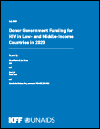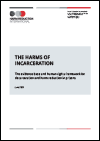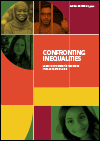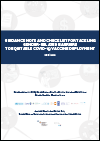What's New
Displaying results 501 - 510 of 4922

Resource | Publications,
Since the framework was launched, UNAIDS and partners have reported annually on progress towards achieving these targets. Since the deadline for achieving the targets passed in December 2020, this is the final Start Free, Stay Free, AIDS Free progress report. Although the targets were global, partners identified 23 countries for intensified focus under the framework. This report specifically highlights progress against the targets in focus countries.

Resource | Publications,
In 2019, there were an estimated 1.9 million people living with HIV (PLHIV) in the Western Pacific Region. Regional HIV prevalence and annual new HIV infections have remained unchanged since 2010 at 0.1% and 100 000 new infections per year, respectively. Among PLHIV, 77% have been diagnosed and 84% of diagnosed PLHIV were receiving antiretroviral therapy (ART). Of those on ART, 94% achieved viral suppression. While countries in the Region are making progress towards elimination of HIV, there were an estimated 437 000 PLHIV still undiagnosed in 2019.

Resource | Publications,
The new report, produced as a long-standing partnership between KFF and UNAIDS for more than 15 years, provides the latest data available on donor government funding based on data provided by governments. It includes their bilateral assistance to low- and middle-income countries and contributions to the Global Fund, UNAIDS, and UNITAID. “Donor government funding” refers to disbursements, or payments, made by donors.

Resource | Publications,
This report highlights several challenges faced by people living with HIV in the country across the HIV care continuum. Issues on various facets of HIV care continuum such as access to HIV facilities and psychosocial support are surfaced and discussed. Policy and program recommendations that will help the in development of the national HIV program that is more robust, with or without the threats of COVID-19, are also presented.

Resource | Publications,
The purpose of this publication is to share leading practices for HIV data quality and to provide standards countries may use to assemble the highest possible quality of programme data for their HIV epidemiological estimates process.

Resource | Publications,
The criminalisation of drug use is prevalent globally, and the availability of harm reduction services is inadequate. However, harm reduction responses for sexualised drug use are even more inadequate, particularly compounded by criminalisation of sex between men. Gay men and other men who have sex with men and people who use stimulants are among the communities insufficiently served by existing or traditional harm reduction services. Furthermore, people engaging in chemsex have multiple vulnerabilities, leading to increased public health risks

Resource | Publications,
This briefing provides advocates with the evidence base and human rights framework for decarceration and the provision of harm reduction services in prisons.

Resource | Publications,
People living with HIV are at a higher risk of severe COVID-19 illness and death, yet the vast majority are denied access to COVID-19 vaccines. Key populations and their sexual partners account for 65% of new HIV infections but are largely left out of both HIV and COVID-19 responses—800 000 children living with HIV are not on the treatment they need to keep them alive.

Resource | Publications,
To maximise the benefits of COVID-19 vaccines, urgent efforts are needed to achieve greater vaccine equity. Addressing the known and emerging gender-related inequities is critical. This Guidance Note and Checklist provide a set of practical actions for countries to advance gender equality and equity in the deployment of COVID-19 vaccines.

Resource | Publications,
The first comprehensive in-depth research into the issue covering 170 countries, finds that though there has been progress on women’s representation overall in public administration, persistent gaps remain. Women continue to hit a glass ceiling and glass walls that stop them from advancing to positions at the highest levels of power and influence, including in the COVID-19 response. The report provides practical recommendations to help shatter these glass ceilings and glass walls and to reimagine and redesign more gender inclusive and diverse public administrations.





